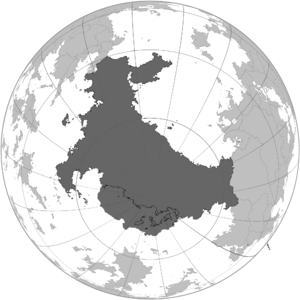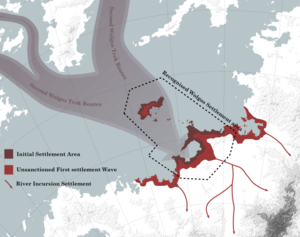Hergom ep swekorwos: Difference between revisions
No edit summary |
|||
| Line 141: | Line 141: | ||
It's important to note that these intricacies may not seamlessly apply to interactions with humans. The Wolgos moral code, intricately woven into their psyche, might not readily translate to human norms. What's deemed a crime or moral transgression in their society may lack translation or comprehension when projected onto human behaviour. | It's important to note that these intricacies may not seamlessly apply to interactions with humans. The Wolgos moral code, intricately woven into their psyche, might not readily translate to human norms. What's deemed a crime or moral transgression in their society may lack translation or comprehension when projected onto human behaviour. | ||
=== Judicial theory === | |||
The concept of justice among the Wolgos differs significantly from that of humans, as their understanding revolves around the notions of harmony and continuity rather than equity and righteousness. Retributive or punitive justice does not serve as the guiding principle for Wolgos justice; instead, they gravitate toward what can be termed as strategic justice. | |||
Interestingly, most actions that may be perceived as crimes are addressed through restorative justice practices, with the aim of restoring collective balance and harmony. The well-being of collective interests takes precedence over the individual's injury. The extent and involvement of restorative practices are highly contingent on the influence wielded by individual Wolgos, their kin, or their tribe. Lone individuals without a close social collective or those of low standing and influence often find themselves at a disadvantage and face significant punitive risks. | |||
Within Wolgos societies, there is no impetus to address power imbalances that disadvantage isolated or low-standing individuals. This is primarily because doing so would diminish the influence and degree of impunity that families, clans, and tribes can leverage. Furthermore, this system of justice serves as an important social mechanism that helps the Wolgos overcome potentially antisocial tendencies. It fosters the need for cooperation and the stability of family, clan, and tribal structures, thereby ensuring the stability of the state itself. | |||
One disadvantage of this system, from a human perspective, is the vast disparity in how crimes are punished or resolved. Grave crimes can go unpunished if influential or powerful individuals exercise significant impunity, particularly if the injured party holds little social capital or importance. Individuals of low standing or social capital can face insurmountable obstacles to justice and are at high risk of exploitation or harm. | |||
It is worth noting that the state is the only party that can achieve complete restitution if injured. Charges brought by the state are usually challenging to dispute, as a crime against the state is seen as a crime against Wolgos kind. Nevertheless, there are checks and balances in place, as they are in the best interest of the state. Wolgos societies can engender a collective sense of paranoia if they perceive the interests of tribes to be threatened. | |||
Revision as of 03:00, 28 August 2023
| Hergom ep Swekorwos Hergom ep Swekorwos | |
| Flag | Coat of arms |
|---|---|

|

|
| Motto: "At the world's very edge, where horizons meet the sky, We rise for our last stand, as the stars bear witness on high. Blood heralds our era, as old tales are undone, For an everlasting dominion, that shall eclipse even the sun." | |
| Anthem: | |
| Locator map | |

| |
| Capital city | sample_city |
| Largest city | Ombhrosdhom |
| Official language | Wolgos language |
| Other languages | Chala |
| Ethnic group | |
| Religion | 53% Dlroch'veldr
15% Nara Akchacknism 15% indigenous beliefs 13% Venara Akchacknism 4% Neo-Shuocian |
| Demonym(s) | Herg |
| Government | |
| Government Type | Unitary Tribal Federation |
| Your 1st leader title (e.g. King) | President Name |
| Your 2nd leader title (e.g. Prime minister) | Vice President Name |
| Legislature | Congress |
| Establishment | |
| Area | |
| Total | 33,082,896.19 km2 |
| Water % | 4.66% |
| Population | |
| Total | 257,345,233 |
| Density | 7.78/km2 |
| Economy | |
| Economy type | Capitalist |
| Currency | Uhum () |
| Development index | 0.920 |
| Other information | |
| Time zone | All time zones |
| Driving side | Left |
| Calling code | +09999 |
| Internet code | -X00900 |
The premier Wolgos nation in Gotha, known as Hergom ep Swerkorwos, is situated in the deep south of the planet. It encompasses the entire region of Kupeya (called Khrupeva by the Wolgos), which includes the South pole, as well as the southernmost part of Tzeraka (called Therakha by the Wolgos). The nation recently celebrated its centenary anniversary, marking the foundation of the state after the dissolution of the Bind and Dhownolgos. Its establishment followed the conclusion of the Pan Oceanic War and the subsequent Second Great Wolgos Trek.
Despite its extensive land area, Hergom ep Swerkorwos primarily experiences challenging climates. Only around fifteen percent of its territory enjoys a temperate climate, while the remaining land is divided into alpine, taiga, tundra, and varying degrees of harsh arctic climates.
The governance of Hergom ep Swerkorwos departs from the monastic and theocratic systems of its predecessors. Instead, the nation is administered by a federated cabal of Wolgos tribes. While tribes often dominate significant stretches of territory, no Weikosa (region) is monopolized by any particular tribe. Tribes are recognized as legal entities with extraterritorial authority, representing the Wolgos and their human subjects. They encompass numerous clans and families, providing economic, legal, and welfare support.
The state does not provide comprehensive welfare services. Instead, the responsibility for healthcare, education, legal aid, security, and economic assistance lies with the tribes. The level of services varies among tribes and is often tied to their economic influence. Wolgos tribe members frequently work in their respective tribes' expansive enterprises or establish businesses associated with their tribe. However, it is not uncommon to find Wolgos working for tribes other than their own, effectively becoming adoptive members of the tribe they collaborate with.
Cities in Hergom ep Swerkorwos are vibrant hubs where diverse tribes cooperate to conduct efficient business. However, conflicts and hostile competition can arise. The government serves as a pseudo tribe composed of representatives from all tribes, working to harmonize relations and maintain a regulatory and legal framework that supports efficient industry and business operations throughout the nation.
While tribes handle most internal affairs, the government retains control over defense, monetary policy, currency minting, the legal system, relief efforts, intelligence operations, and foreign policy. Defense, infrastructure investments, and intelligence comprise the largest government expenditures. To fund its operations, the government imposes a percentage of revenue and various taxes and fees on the tribes for the services it provides.
As part of its foreign policy, the government exercises control over a number of sorikwentom (corporations and associations). Some of these entities are known to oversee twenty-seven major criminal networks across Gotha. These corporations engage in illicit activities such as distributing drugs, arms manufactured in Hergom, and a range of other illegal operations. The significant profits generated from these activities contribute to Hergom's foreign currency reserves.
Etymology
"Hergom ep Swekorwos" can be interpreted as "Enduring Strength at the World's End" or "Resilient Power at the Edge of the World." It conveys the idea of a powerful and enduring Wolgos nation located in a remote and distant region.
7598 - 7603 Wolgos Scourge (20's to early 30's tech leap) 7603 - 7620 Second Wolgos Trek 7608 Foundation of hergom
History
- See also: Dhonowlgos
- See also: The Bind
- Main article: History of Hergom
Pre-Wolgos History
For much of its historical narrative, Kupeya remained ensconced within a realm of limited development. Its northern coast extended as a slender belt of temperate land, while the continent itself boasted a penchant for climatic variability that rendered its colder boreal interior inhospitable to pre-industrial societies.
Along this coastal fringe, a string of modest Chalam princedoms emerged over time, forming clusters of villages dependent upon subsistence farming and fishing. These entities occasionally engaged in trade with the warmer Raian archipelago, a connection that punctuated their existence.
Venturing further into the continent's heart revealed hunter-gatherer villages strewn across the landscape, punctuated occasionally by subsistence trading communities settled along the meandering banks of the continent's intricate river networks. The Phula and Alutean peninsula, in contrast, gave rise to societies of greater advancement, characterized by their capacity to erect permanent stone and earth mound temples. Within most of these villages and towns, palisades stood sentinel, and communal grain silos stored the bounty of the subtropical climate, offering these societies an abundance of crops.
Among these regions, Alutea stands as the sole recipient of Ithrien's colonial influence. Trading outposts and coastal holdings established by Ithrienian lords endowed Alutea with a more advanced societal landscape. In exchange for valuable commodities such as cassava, sea products, and even slaves, Alutea engaged in an exchange with Ithrien, elevating its position on the developmental spectrum.
Kupeya occupies a place of profound historical remoteness within the fabric of Gotha, a distinction shared only with central Davai. Its proximity to the southern polar cap shielded Kupeya from the classical hemisphere and its confinement by the dense Raian archipelago to the north have sealed its isolation. This archipelago, once a sprawling realm cloaked in rainforest and coastal cultures trading in spices and tropical treasures, bore witness to piracy and commerce.
Despite its geographic connection to Raia, the region bordering Kupeya has remained veiled in dense, nearly impenetrable rainforests. Consequently, the allure of colonization never extended its grasp here, untouched by the ambitions of both Anarians and Western Davai. Anarians mapped and explored the region but ultimately viewed it as less promising compared to the fertile colonial prospects of Altaia, D’runia, Tzeraka, and the Shangti.
7603 - 7620 - Second Wolgos Trek

Following the tumultuous aftermath of the Wolgos Scourge, a profound transformation unfolded within Kupeya, catalyzed by what would come to be known as the Second Wolgos Trek. This phase of history witnessed the Peleykros peninsula becoming a converging point for an unparalleled influx of Wolgos migrants, reshaping the region's very fabric.
In the wake of the devastating Wolgos Scourge, the remnants of the once-mighty Bind navy and merchant marine embarked on a grand and audacious endeavor. This involved orchestrating an extensive logistical operation that aimed not only to relocate a vast number of people but also to transport vital machinery and equipment salvaged from the now-ravaged Altaia. To facilitate this ambitious migration, the Bind administration spared no expense, even to the point of financial ruin. They turned to Kamura and others for much-needed assistance, forming a coalition of resources to tackle this Herculean task.
Amid these transformative events, it's crucial to note that the Wolgos migration was not without financial repercussions. The Bind administration, in their determination to orchestrate this ambitious migration, expended significant resources, ultimately leading to their bankruptcy.

The logistical complexity of the migration was staggering, involving the movement of countless Wolgos individuals, often accompanied by their Shriaav allies. Over a span of fifteen years, this massive operation facilitated the transportation of approximately forty million Wolgos and three million Shriaav from Altaia to Kupeya, creating a phenomenon of unprecedented scope.
However, not all Wolgos were prepared to sever their connections with their adopted home. An estimated eight million Wolgos chose to remain in Altaia, displaying a deep attachment to the land despite the challenges that had befallen it. An additional two million Wolgos dispersed across the Shangti region, charting divergent paths amidst this epochal transformation.
For the Wolgos who remained behind, they encountered not only political and economic hurdles but also the weight of anti-Wolgos prejudices as a result of the war they had instigated. Despite these trials, over the following decades, they and their descendants made the decision to migrate to Kupeya, drawn by the promise of new beginnings and opportunities. Nevertheless, even as the majority found their way to Kupeya, over three million Wolgos remain scattered beyond the confines of Hergom.
The initial years in Kupeya were a crucible of trials. Struggles emerged as the Wolgos migrants confronted both the indigenous populations of the region and the scarcity of sustenance. The initial reliance on imported food resources gradually waned, further exacerbating the challenges faced by the newcomers.
As the availability of imports dwindled, the Wolgos community pivoted toward adapting to their new surroundings. The fertile expanse of the Wodranis river plains assumed a central role in this adaptation process. Here, a concerted effort unfolded, marked by the ravenous consumption of native wildlife and the indigenous inhabitants. These resources served as a lifeline, providing sustenance in the midst of change.
This era of transformation also bore witness to the rise of new infrastructural developments. The remaining fragments of the Bind administration moved swiftly to establish a rudimentary construction industry. Fishing ports emerged, along with the construction of docks along the Wodranis and Pleudhara rivers. These pivotal developments not only bolstered the burgeoning settlements but also streamlined the transportation of essential resources, particularly grains and sustenance, back to Ombhrosdhom. This evolving nucleus evolved into a thriving city at the heart of Kupeya's metamorphosis.
7608 Foundation of Hergom ep Swekorwos
7632 - 7634 First Coalition War
7663 - 7664 Second Coalition War
7664 - First use of nuclear weapons in Ephesus Front by the Coalition
7664 - End of the Second coalition war
7665 - Establishment of the Tzeraka demarcation border
7672 - First Wolgos nuclear Test
7681 - Non-Proliferation Treaty
7689 - Current Era
Government
Justice
Criminal Theory
At the heart of the Wolgos legal framework lies a strategic approach, a reflection of their innate psychopathic tendencies. For the Wolgos, crime is not solely an act that disrupts social harmony but rather one that upends the delicate balance of power and authority. Actions that threaten the interests of the state, society, tribe, or influential individuals are marked as criminal, mirroring their stratified society where not all Wolgos are equal in the eyes of the law.
However, the determination of what constitutes a crime isn't solely rooted in strategic considerations. Established Wolgos norms, often intertwined with religious dogma, play a significant role in shaping the boundaries of acceptable behavior. The teachings of Dlroch'vlder serve as a moral compass, guiding the complex interplay between morality and strategic considerations.
The Wolgos, though not innately collectivist, have developed a strategic collectivist perspective through their evolution within larger and more intricate societies. Adhering to established moral norms has become crucial as they navigate these complexities. Dlroch'vlder's teachings provide a shared ethical foundation, allowing the Wolgos to construct a unique sense of morality in the midst of shifting power dynamics.
Within Wolgos society, a notion of general rights and expectations for the Wolgos alone exists, though tinged with nuances. Equality isn't uniform; instead, a spectrum of equality prevails, where certain individuals are inherently more equal than others. This hierarchy aligns with the strategic nature of their society, where power and influence intricately shape the definitions of right and wrong.
It's important to note that these intricacies may not seamlessly apply to interactions with humans. The Wolgos moral code, intricately woven into their psyche, might not readily translate to human norms. What's deemed a crime or moral transgression in their society may lack translation or comprehension when projected onto human behaviour.
Judicial theory
The concept of justice among the Wolgos differs significantly from that of humans, as their understanding revolves around the notions of harmony and continuity rather than equity and righteousness. Retributive or punitive justice does not serve as the guiding principle for Wolgos justice; instead, they gravitate toward what can be termed as strategic justice.
Interestingly, most actions that may be perceived as crimes are addressed through restorative justice practices, with the aim of restoring collective balance and harmony. The well-being of collective interests takes precedence over the individual's injury. The extent and involvement of restorative practices are highly contingent on the influence wielded by individual Wolgos, their kin, or their tribe. Lone individuals without a close social collective or those of low standing and influence often find themselves at a disadvantage and face significant punitive risks.
Within Wolgos societies, there is no impetus to address power imbalances that disadvantage isolated or low-standing individuals. This is primarily because doing so would diminish the influence and degree of impunity that families, clans, and tribes can leverage. Furthermore, this system of justice serves as an important social mechanism that helps the Wolgos overcome potentially antisocial tendencies. It fosters the need for cooperation and the stability of family, clan, and tribal structures, thereby ensuring the stability of the state itself.
One disadvantage of this system, from a human perspective, is the vast disparity in how crimes are punished or resolved. Grave crimes can go unpunished if influential or powerful individuals exercise significant impunity, particularly if the injured party holds little social capital or importance. Individuals of low standing or social capital can face insurmountable obstacles to justice and are at high risk of exploitation or harm.
It is worth noting that the state is the only party that can achieve complete restitution if injured. Charges brought by the state are usually challenging to dispute, as a crime against the state is seen as a crime against Wolgos kind. Nevertheless, there are checks and balances in place, as they are in the best interest of the state. Wolgos societies can engender a collective sense of paranoia if they perceive the interests of tribes to be threatened.